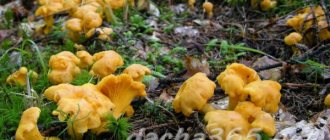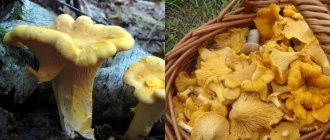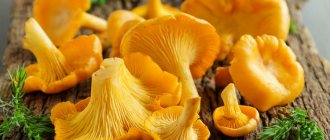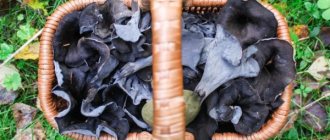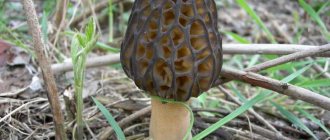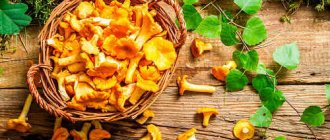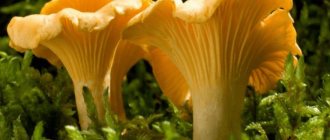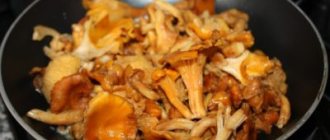Chanterelles
Among the many mushrooms, the most popular are chanterelles. These are edible mushrooms whose color ranges from pale yellow to orange. They have a rather unusual shape - the center of the cap is concave inward, the edges are curled and uneven.
The chanterelle's leg is small, strong, and the same color as the cap. It should also be noted that the lower part of the mushroom grows tightly together with the upper. The mushroom itself is small - the diameter of the cap is from 2 to 10 cm.
Appearance
The type representative of the genus is the common chanterelle. This is an edible mushroom in which the stem is fused with the cap. It has an orange tint, which can change to egg, yellow, etc. Sometimes the color fades to almost white.
Fox hats
The shape of the cap changes depending on maturity.
At first it is slightly convex, then gradually takes on the shape of a funnel, most often irregular. The cap grows up to 10 cm, on average about 5 cm. The consistency is fleshy and smooth. The edges are wavy and uneven. Interesting fact : chanterelles, as a rule, are not wormy, with rare exceptions.
The leg does not differ in color. It is dense, smooth, thin at the bottom and thickens towards the top. The average height is about 6 cm, thickness is no more than 3 cm. The flesh is also dense, yellow or orange. It is characterized by a slightly pungent taste and fruity smell.
Chanterelle hymenophore
The hymenophore is folded in the form of false plates. They are thick, not densely spaced, from the cap they go straight down to the stem and smoothly pass into it. The spores are yellow.
Evaluation of taste qualities, medicinal properties, benefits and possible harm
Mushrooms have a specific taste. They have a sour tint and can become bitter if not cooked correctly. In Europe, this product is practically not consumed as food.
But Russians attribute special medicinal properties to chanterelles. They are believed to:
- strengthen nails, hair and improve skin condition, as they contain 8 essential amino acids;
- help the body with hepatitis C, as they include trametonolinic acid;
- effective in the fight against anemia, because they contain a lot of iron and vitamin C. 300 g of the product, when fully absorbed, provides the body with the daily norm;
- useful for colds, are natural antibiotics, fight tubercle bacilli;
- effective in the fight against parasites and worm eggs (chitinmannosis);
- restore vision and resist tumor diseases (vitamins, minerals);
- treat the pancreas and liver (in the form of alcohol-based substances).
The advantage and benefit of this product is determined by the overall effect on the body:
- anti-inflammatory;
- bactericidal;
- immunostimulating;
- anthelmintic;
- restoring nerve connections.
There are no special contraindications. You should take various kinds of chanterelle tinctures and decoctions with caution.
People who have a disease of the digestive organs, as well as children under 5 years of age, should limit their consumption.
Where do they grow?
Chanterelles have varied preferences for certain tree species. You should look for them under spruce, oak, pine, and beech trees. They can grow in any forest. Often found among birch groves.
Chanterelles grow on a pine forest floor
Mushrooms love high humidity, so they often grow on coniferous or deciduous litter, among mosses. May be found nearby with rotten trees. They usually grow in groups, so if you find one mushroom, there are probably others nearby.
Interesting fact : chanterelles are not afraid of bad weather, unlike other mushrooms. So, during drought they simply stop growing, do not dry out, and during heavy rains they do not rot.
Places of growth
The chanterelle mushroom is edible and has about 60 varieties. Their peculiarity is a bright, rich color and a cap that is almost completely fused with the stem.
The main habitats are mixed and coniferous forests of the temperate zone. Chanterelles are found both in Kuban and Siberia.
As a rule, they grow in large groups, so you can easily collect so many of them that there will be enough for a whole year of pickles, marinades or roasts.
Reference! These mushrooms are found almost all over the planet - in Europe, Asia, America and Africa. They are loved by gourmets all over the world.
How long does it take to grow?
The ripening time of mushrooms depends on weather conditions. After heavy rains, you can go looking for chanterelles within a couple of days. In general, they need about a week to reach the required size. It is recommended to avoid overripe specimens, as they accumulate harmful substances and toxins.
Chanterelles can deteriorate and rot, like any other mushrooms. However, they are characterized by one feature - neat rotting. Damaged mushroom pulp stands out noticeably and can be easily removed.
Video gallery
Video reviews
A selection of videos with descriptions and recipes for preparing mushrooms
about Mushrooms and Plants in Your Own Words, Mushrooms of Ukraine / Mushrooms of Ukraine, Olga Matvey
Types of chanterelles, names and photos
In addition to the common chanterelle, the following species are known:
- gray;
- tube-shaped;
- black;
- pale (white);
- yellowing;
- amethyst;
- velvety;
- faceted;
- cinnabar red;
- club-shaped.
Gray fox
The gray chanterelle or funnel funnel is considered a conditionally edible mushroom that has almost no taste. The cap is curved, funnel-shaped, and has a gray-brown tint. The folds on the inside are usually lighter. The leg is small, thin, ashy in color. The mushroom usually grows in groups.
Interesting: Boletus - description, what it looks like, where it grows, when to collect, varieties, photos and videos
Gray fox
Tube-shaped fox
The tube-shaped chanterelle is edible and small. The cap is about 3-4 cm, the leg is no more than 6 cm. The color is brown and dull. The leg is slightly lighter, smoothly transitions to the upper part. The edges are torn and significantly concave inward. The color is not uniform.
Tube-shaped fox
False plates of a light shade. The smell is mushroom, pleasant. The tube-shaped chanterelle grows from August to the end of October. Found near coniferous trees.
Black fox
Black chanterelle is conditionally edible, dark gray in color. The hat and the leg are one whole. The surface is dry and uneven. The hat is darker, funnel-shaped. The edges are light and curved upward. There are no false plates on the back of the cap.
Black fox
The leg is hollow, up to 10 cm in height. The pulp of the mushroom is very fragile and thin. There is practically no smell. After heat treatment it becomes black. Grows from July to the end of September. Only the caps are eaten.
Pale (white, light) fox
The pale (white, light) fox is very similar to the common one. The main difference is the light, uneven shade, which can be white, cream, or pale yellow. False plates of the same color. The mushroom grows in June-September.
White fox
Yellowing fox
The edible yellowing chanterelle grows primarily near coniferous trees. The caps are small (up to 5 cm), funnel-shaped with a large depression. The edges are sinuous, concave inward. The shade is brown with a yellow tint.
Chanterelle yellowing
The leg is tall, thin, narrow at the base, yellow-orange. The hymenophore is folded, light. The pulp is fragile but dense. The nutritional value is low.
Amethyst fox
The amethyst fox is a large representative of the genus. It is distinguished by a dense thick stem - up to 4 cm in thickness, as well as an asymmetrical cap with torn, curved edges. The size of the cap varies from 2 to 10 cm. Its shape can be convex, flat, with a funnel in the center, depending on age.
Amethyst fox
The color of the mushroom is yellow, dark or rich with various spots. The stem and hymenophore match the color of the cap. The chanterelle grows from June to October in forests of any type.
Velvety fox
The velvety chanterelle is a rare species that grows in the deciduous forests of southeastern Europe. The cap is about 4 cm, can be convex or funnel-shaped. Shade – red-orange or bright yellow. The edges are wavy. The leg is small, thin, yellow. The pulp may be orange, yellow, or white.
Velvety fox
Faceted chanterelle
The faceted chanterelle is an edible species. Usually grows near oak trees in groups. A characteristic feature of the species is an even more wavy, uneven cap, its edges hanging down. The dimensions of the fruiting body are from 2 to 10 cm. The color is bright yellow or orange. The folds are sparsely spaced or absent. Fruits all summer and until autumn.
Faceted chanterelle
Cinnabar-red fox
The vibrant cinnabar red chanterelle stands out in its rich red-orange color. These mushrooms are small: the cap is no more than 4 cm, the stem is also up to 4 cm in height. The shape of the cap is convex at first, then becomes flat or slightly concave. The pseudoplates are thick, the same color as the fruiting body. Chanterelle grows near oak trees in summer and autumn.
Cinnabar-red fox
Club-shaped fox
The club-shaped chanterelle has good taste. Quite a large mushroom: height up to 16 cm, thickness up to 10 cm. It grows in groups, and several fruiting bodies can grow together. The hat and leg are connected.
Club-shaped fox
Young mushrooms have a purple cap, which gradually changes to yellow. The leg is yellow-brown, covered with folds, and sometimes hollow. The mushroom grows from early summer to late autumn. It has white aromatic pulp and a pleasant taste.
Chanterelle recipes
Cooking chanterelles
Chanterelles are widely used in the preparation of various dishes, and therefore are a welcome find for any mushroom picker. Both fresh and dried mushrooms are used in cooking. Here are some recipes for cooking chanterelles.
Country-style chanterelles
Will need:
- 500 g fresh chanterelles,
- 3 tbsp. spoons of chopped onion,
- 100 g vegetable oil,
- ground black pepper, salt.
Preparation:
- Boil the prepared mushrooms in salted water and chop.
- Heat oil in a large frying pan.
- Place the mushrooms in a frying pan along with the onions, add salt and pepper.
- Simmer over low heat for about an hour.
- Before serving, sprinkle with chopped herbs.
Salad with chicken and mushrooms
Will need:
- 150 g boiled chicken,
- 250 g boiled chanterelles,
- 30 g cheese,
- 2 boiled eggs,
- 1 pickled cucumber,
- 1 onion,
- 1 tbsp. spoon of vegetable oil,
- 4 tbsp. spoons of mayonnaise,
- greens, salt.
Preparation:
- Chop the onion and fry in oil.
- Grate the cheese on a coarse grater.
- Chop the eggs.
- Cut the mushrooms, chicken and cucumber into strips.
- Combine the prepared ingredients, add salt, add mayonnaise and mix.
Mushroom sauce
Will need:
- 150 g dried chanterelles,
- 100 g flour,
- 100 g butter,
- 200 g sour cream,
- salt, ground black pepper.
Preparation:
- Soak the mushrooms, boil and chop.
- Strain the broth.
- Saute the flour in oil, then gradually pour in the broth, salt, pepper, sour cream, mushrooms and boil.
Thus, chanterelle is a very useful mushroom with a unique composition. It is used not only as an ingredient for various dishes, but also as a medicine. It is important to distinguish the common chanterelle from its dangerous counterparts. You should also pay attention to contraindications for eating chanterelles. If you follow all the rules for collecting and preparing, chanterelle dishes will delight you with excellent taste.
Inedible and poisonous species
Orange talker
The orange talker has a small convex cap, which becomes flatter with age. The surface is dry, velvety. Various shades of orange are possible. The plates are of a brighter shade. When you press on them, brown spots appear.
Orange talker
The leg is low, up to 1 cm in diameter. The color is the same as the cap or more saturated. The pulp is dense, and in mature mushrooms it becomes cotton-like. White spore powder. The smell is weak, the taste is unpleasant, almost unnoticeable.
Interesting: Why are chanterelles not wormy? Reasons, photos and videos
False chanterelles grow from August to the end of October. The growing conditions are the same as for the edible mushroom. For a long time, the talker was considered poisonous. Now it is classified as a mildly poisonous or conditionally edible mushroom - there is no consensus. Experts advise refraining from eating it.
Red false fox
The red false fox has only recently become an independent species. The cap of this mushroom grows up to 10 cm. Possible shades: yellow, orange, brownish. It is worth noting a darker spot in the center of the cap, as well as noticeable small scales.
Red false fox
Scales are also visible on the leg. Its color matches the color of the cap. The pulp is orange in color and does not change color when damaged. The smell and taste are weak. The mushroom is considered conditionally edible, but its nutritional properties are very low.
Omphalotus oleifera
Omphalotus oleifera is an inedible poisonous mushroom. Inexperienced mushroom pickers may confuse it with chanterelle, which can lead to poisoning. The hat changes shape depending on age. First convex, then flat or funnel-shaped. The edges are strongly curved inward. Color ranges from pale yellow to orange-brown.
Omphalotus oleifera
Interesting fact : Omphalotus oleifera plates can emit a faint glow at night.
The leg is uneven and dense. It may be the same color as the cap or a little lighter. The pulp is fibrous, yellow. The smell of the mushroom is unpleasant, and there is almost no taste. Omphalotuses grow near deciduous trees, on olive stumps. The growth period is all summer and autumn.
Yellow hedgehog
Separately, it is worth noting the yellow hedgehog . This mushroom is similar in appearance to a chanterelle, but even if there is confusion, nothing bad will happen. The blackberry is absolutely edible with excellent nutritional qualities. Unlike chanterelles, under the cap there are not plates, but small spike-like growths that easily break off. The taste is identical to chanterelles.
Yellow hedgehog
General distinctive features of the edible chanterelle from its counterparts:
- Color . Chanterelles usually have an even shade without spots, streaks, etc.
- Smell . The fruity aroma of edible chanterelle is unlike its counterparts, which have almost no smell or emit an unpleasant odor.
- Hat . The edges are always uneven and curved.
- Leg . Always dense in the edible species and hollow or loose in some lookalikes.
- Worminess . Very rarely, chanterelles attract insects, while false species are not endowed with this property.
Some tips for storing chanterelles
In order not to lose the excellent taste, aroma and beneficial properties of these mushrooms, you need to know the rules for their processing:
- Despite the fact that chanterelles keep their shape well and are easy to transport, they cannot be stored for a long time. Maximum 1-2 days in the refrigerator and only in open glass or enamel containers. In plastic bags, mushrooms instantly get wet and become moldy.
- During heat treatment, all vitamins in chanterelles are completely destroyed. Therefore, for medicinal purposes, it is better to dry them at a temperature not exceeding 45°C. The prepared raw materials are ground into powder and used as a seasoning or in traditional medicine recipes.
- When thawing after freezing, chanterelles may become bitter. It is better not to freeze them. But if you still have to do this, then you first need to boil the mushrooms in milk for 15-20 minutes or fry them in butter. Then after freezing they will not change their light fruity taste.
- Chanterelles store well when fried. To do this, heat the vegetable oil well in a frying pan. Washed and dried mushrooms are fried for 30 minutes with the addition of salt and bay leaf. The chanterelles can be boiled first. The finished mushrooms are transferred to sterilized jars and hermetically sealed. Then they need to be wrapped tightly and left to cool completely. Shelf life: 6 months in the refrigerator.
- You can salt the chanterelles after preliminary boiling for 15-20 minutes. Then the mushrooms are washed, placed in an enamel pan, sprinkled with salt in layers (2 tbsp per 1 kg of chanterelles). Oppression is placed on top. After a month, the mushrooms can be transferred from the brine to jars. Salted chanterelles should be stored in the refrigerator.
- Pickled chanterelles cook faster. The mushrooms are boiled, placed in sterilized jars and poured with boiling marinade (for 1 liter of water, 3 tablespoons of salt, ½ tablespoon of sugar, 2-3 cloves of garlic and 1 tablespoon of 9% vinegar). Chanterelles prepared in this way are stored for up to 1 year.
Why do chanterelles taste bitter?
The bitter taste in chanterelles occurs due to violations of the technology for preparing and storing mushrooms, as well as in case of errors during their collection.
It is recommended to collect chanterelles at a young age, when they have not yet acquired a rich orange color. You should avoid going for mushrooms during the dry season, and also avoid chanterelles growing along highways and near industrial facilities. Such mushrooms accumulate many toxins and harmful substances.
Quite often, bitterness appears in chanterelles growing in coniferous forests
All of the above conditions for mushroom growth can cause their bitterness. Separately, false chanterelles can be noted. Once a couple of these lookalikes get into a dish with edible mushrooms, the taste will be ruined.
Improper processing of mushrooms can also cause a bitter taste. For example, before freezing, chanterelles need to be cleaned, cut out all damaged areas, washed, soaked in salt water for several hours and boiled for about 8 minutes. It is important to harvest mushrooms as soon as possible after harvesting.
In which forest do chanterelles grow and when to collect them?
From June to mid-October, chanterelles can be found mainly in coniferous forests, as well as in mixed forests.
. Most often, mushrooms are found in damp areas, in moss, among grass, near pines, spruces, and oaks.
You can meet chanterelles in numerous groups, appearing en masse after thunderstorms.
Why are chanterelles not wormy?
Worminess in chanterelles is a very rare occurrence, thanks to a special substance contained in these mushrooms. We are talking about D-mannose or quinomannose, a natural monosaccharide.
Hinomannose repels various insects, parasites, and helminths. Moreover, the substance acts on both adult individuals and their larvae. As soon as an insect comes into contact with quinomannose, the monosaccharide begins to have a paralyzing effect on it.
Interesting fact : D-mannose is destroyed at temperatures of +50℃ and above, as well as upon contact with acids and salts.
Still there are some exceptions. For example, wireworm larvae and black beetle larvae are not afraid of quinomannose, so they can sometimes be found in chanterelles. Their bodies are covered with a denser shell compared to other worms, which serves as protection against the monosaccharide.
How to freeze chanterelles for the winter?
Clean the mushrooms from dirt, rinse and dry on a towel. You can freeze fresh, boiled, fried chanterelles.
When eaten raw after freezing, mushrooms may taste bitter.
Place the prepared mushrooms in bags or food containers and close tightly. Store in the freezer for 1 year at a temperature of -18 degrees.
You need to defrost the chanterelles in the refrigerator on the bottom shelf, at a temperature of +4 degrees. Thawed mushrooms cannot be re-frozen.
Return to contents
Beneficial features
Chanterelles have high nutritional and energy value. The calorie content of the mushroom is 19 kcal/100 g. Also, 100 grams of chanterelles contain:
- proteins – 1.5 g;
- fat – 1.1 g;
- carbohydrates – 1.1 g.
Interesting: Boletus - description, what it looks like, where it grows, varieties, photos and videos
Chanterelles are rich in amino acids, vitamins (C, A, E, B1, B2, D2), microelements (zinc, calcium, potassium, iron, chromium), as well as trametonolinic acid. They contain ergosterol, which has a beneficial effect on liver function, and K-10 polysaccharide. Quinomannose has an antibacterial effect.
Interesting facts about chanterelles
- In the forest, these mushrooms grow in the form of so-called “witch’s rings.”
- They contain an antibiotic that kills Koch's bacillus, the cause of tuberculosis.
- When heated, all the vitamins contained in them are destroyed.
- Chanterelle contains more vitamin A than carrots. And in China, they are used to treat night blindness and visual impairment.
- In Africa, cosmetic masks, creams and lotions are prepared from chanterelles. In the USA, a chef competition is held annually to find the most original dish made from these mushrooms.
- The largest varieties grow in California. Their weight reaches 500 grams.
Why are chanterelles called that? Other names
The Latin name for the common chanterelle is Cantharellus cibarius. This is how the mushroom was named by the Swedish mycologist Elias Magnus Fries in 1821. This name can be roughly translated as “edible bowl,” which is probably due to the funnel-shaped shape of the cap.
The Russian version of the name “chanterelle” is primarily associated with the red fox, and it is no coincidence. The fact is that these words come from the Old Russian “fox” - that is, “yellow, red”.
The first to officially describe and name the chanterelle mushroom was the Swedish scientist Carl Linnaeus in 1753 - Agaricus cantharellus
Other names are also used by people: real chanterelle, cockerel and sploen. The last two options are associated with the uneven curved edges of the cap.
Most other countries use names for this mushroom that are derived from the Latin form. For example, in English, Norwegian, and French, a chanterelle is called chanterelle, and in Danish – kantarel.
Some languages have their own approach. The Germans call the mushroom “a real chanterelle (cheat)” - Echter Pfifferling. The second name is Eierschwammerl, which means egg mushroom. Translated from Chinese, 鸡油菌 means “yolk-colored mushroom.”
Popular methods of preparing the delicacy we are considering
As we found out earlier, chanterelles cannot boast of a long shelf life. Based on this, it follows that the product must be cooked or heat-treated within the first 24 hours after harvest.
We present to your attention the most popular ways to increase the shelf life of a product.
Cooking
It is believed that it is best to pre-boil any mushroom, and only then fry, salt, marinate or add to any dishes. This rule primarily applies to chanterelles, since it is after treatment with boiling water that the fruiting bodies of the plant lose their bitterness. If you want to cook chanterelles for dinner or stock up on them for future use, boil them on the stove or using a slow cooker, and then use them according to the previously planned “scenario”.
Frying
You can fry chanterelle mushrooms either raw or boiled. Cut the fruits into equal pieces and safely place them in a hot frying pan with oil. You will notice how first all the juice from the product will evaporate, and then the mushrooms will begin to fry and emit a pleasant aroma. The optimal preparation time for the treat is 30-40 minutes. Ideal additional ingredients are onions, pepper, salt, dill and sour cream.
Watch the video on how to deliciously fry mushrooms.
Drying
If you decide to dry the harvested crop, it is important that it does not come into contact with water. Clean the fruits with a napkin or damp cloth, then hang the “mushroom beads” in a warm room or place the delicacy in the oven (you can use a special dryer). Check the condition of the product every hour; if you overcook the chanterelles, the raw materials will literally begin to crumble in your hands, and will also lose a significant part of the useful elements.
Pickled
Chanterelles can also be pickled by wrapping them in sterile jars. There are a huge variety of pickling recipes, because each housewife optimizes the “sequence” of actions and ingredients to suit her own individual preferences. If we talk about the classic pickling recipe, mushrooms are boiled in salted water with the addition of citric acid, after which they are placed in jars and filled with liquid with vinegar, salt and seasonings. It is very important to re-sterilize already filled jars, this will eliminate the risk of the snack spoiling or becoming moldy.
Preparation and storage
Mushrooms are easily cleaned of dirt with a soft brush - there is no need to peel off the skin from them, as with other types. Storage in a cool place (up to +10℃) is possible for two days, no more.
Dried chanterelles
Chanterelles are versatile in terms of cooking. They can be boiled, fried, dried, pickled and salted, and also frozen. They cannot be re-frozen.
Contraindications
Among the contraindications to the use of chanterelles are:
- Individual intolerance to chanterelles or mushrooms in general.
- Age up to three years.
- Pregnancy.
- Breastfeeding period.
People suffering from diseases of the gastrointestinal tract should treat chanterelles with caution, since mushrooms are difficult to digest foods. It is also important to pay attention that the chanterelles were collected in an environmentally friendly area and were not overripe.
Growing chanterelles at home
It is possible to grow chanterelles on a personal plot, but it requires creating conditions close to natural ones. To grow mushrooms at home or in the country, you need to acquire mycelium or planting material (caps). It is worth noting that the first option is more reliable, and the second, if successful, will produce a harvest faster.
Chanterelle mycelium is sold in specialized stores. You can also collect it yourself in places where mushrooms constantly grow. This is done by digging out the top layer of soil (about 15 cm deep). It is important to collect and transport the soil carefully, since the mushroom threads are very thin.
Mycelium (mycelium)
The mycelium is kept in small separate containers for a year at low temperatures. This will help him become more resilient. If the planting material was purchased at the store, you can immediately begin planting.
The optimal time is June. Chanterelle mycelium is planted next to the most suitable trees for these mushrooms. It is poured into a hole about 20 cm deep, compacted, and watered abundantly. For wintering, planted areas are insulated with coniferous litter, dry leaves, branches, etc.
Interesting fact : chanterelles are not grown in greenhouses. The presence of natural conditions is mandatory for them.
To grow chanterelle caps, they are soaked in slightly sweet water for 15 hours. A liter of water requires 100 g of sugar. Then the caps are thoroughly crushed, and the resulting liquid mixture is filtered, but there is no need to throw anything away.
It is important to choose a place for planting next to the same tree near which the mushrooms were collected. The top layer of soil is removed, and the soil is watered with a decoction of oak bark. This is necessary to combat microorganisms.
After a couple of hours, the liquid with fungal spores is poured onto the selected area, and the pulp is spread on the bare areas of the tree roots. Then the planting site is covered with earth and watered moderately. In winter it is also covered with branches or hay. The first harvest can be expected in a year.
Application of plant fruiting bodies
Let’s pay a little attention to the areas of life activity in which chanterelles are used.
First of all, it's cooking.
As we noted earlier, the mushrooms we are considering are incredibly aromatic and pleasant to the taste. Experienced housewives and good cooks have become adept at boiling, frying, salting, pickling and even drying the delicacy. In addition to independent dishes, chanterelles harmonize perfectly in salads, sauces, soups and baked goods. The ideal simple side dish for the product is potatoes, rice, pasta or buckwheat. As for seasonings and spices for piquancy, the taste of chanterelles is even brighter if you add pepper, bay leaf, dill, celery or clove inflorescences to them.
Chanterelles in medicine
Traditional healers, healers and representatives of traditional pharmaceuticals are firmly convinced that chanterelles bring great benefits to the human body. Tinctures, extracts, tablets, and ointments are made from the fruiting bodies of the plant. Such remedies are useful for deteriorating vision, fungal or other skin lesions, infection with worms, as well as for diseases of the liver and respiratory tract. As for more severe ailments, the plant is useful in combination with other medications in the treatment of sarcoma, tuberculosis, and tumors. Are you sick with ARVI or tonsillitis? Mushrooms will help you get back on your feet much faster.
Fighting obesity or slight excess weight
Like any other mushrooms, chanterelles perfectly satisfy the feeling of hunger, and you only need to eat 100-150 grams of them. Due to its low calorie content, the product will not be “deposited” in the body, which means it will not add centimeters to the sides. People who practice weight loss diets know very well that mushrooms can replace high-calorie meat - it is enough to consume the product two to three times a week so that the body receives the required amount of nutrients and minerals. If the diet is “associated” with medical recommendations (for example, in case of digestive problems), it is best to give preference to boiled or stewed fruiting bodies. In just a few months of using such a “menu” you can get rid of 3-7 unwanted kilograms (individually, since everyone’s metabolism is different).
Chanterelles in cosmetology
In addition to traditional medicine, the fruits of the culture we are considering are in demand in cosmetology. For example, dried, powdered chanterelles are an important ingredient in anti-aging, moisturizing, and toning creams/ointments. Extracts or alcohol tinctures based on forest gifts are also effective in skin care. The nutrient can be purchased at a pharmacy or prepared independently; the Internet contains a large number of corresponding recipes.
Of course, for each of the described “cases” you need a certain, useful variety of chanterelles. That is why next we will look at the most famous edible chanterelles from more than 60 representatives of the family.

